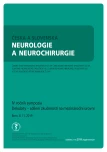Hyperbaric oxygen therapy in non-healing ulcerations – mechanisms of action, current european recommendations and case report
Authors:
M. Hájek 1,2; J. Klugarová 3; D. Chmelař 2,4; M. Klugar 3
Authors‘ workplace:
Centrum hyperbarické medicíny, Městská nemocnice Ostrava
1; Katedra biomedicínských oborů, LF Ostravské univerzity v Ostravě
2; České národní centrum Evidence-Based Healthcare a Knowledge Translation (Cochrane ČR, České CEHBC: JBI centrum excelence, GRADE centrum MU), Institut biostatistiky a analýz, LF MU, Brno
3; Referenční laboratoř ČR pro anaerobní bakterie, LF Ostravské univerzity v Ostravě
4
Published in:
Cesk Slov Neurol N 2019; 82(Supplementum 1): 56-59
Category:
Original Paper
doi:
https://doi.org/10.14735/amcsnn2019S56
Overview
Nonhealing ulcers especially in diabetes and critical limb ischemia are the source of major problems and financial costs for both patients and health systems. The causes of diabetic foot ulcers are multifactorial and involve neuropathy and angiopathy, leading to functional disturbances in the macrocirculation and skin microcirculation. The amputation occurs in about 20% of cases of diabetic foot ulcers. The incidence of amputations in this patient population is 15× higher and make up 50– 70% of all non-traumatic amputations. The main aim of patients, caregivers and healthcare payers should be a reduction of the high rate of major amputations. Despite advances in improving diabetes care there is still need to identify reserves in the form of new therapeutic strategies and methods. They undoubtedly include the systemic administration of hyperbaric oxygen, which according to the current evidence seems to reduce the need for amputation and increase the number of completely healed wounds.
Keywords:
hyperbaric oxygen therapy – infection – hyperoxia – ischaemia – neuropathy
Sources
1. Stryja J, Hájek M. Obtížně se hojící ulcerace a syndrom diabetické nohy. In: Hájek M (ed). Hyperbarická medicína. Praha: Mladá fronta 2017: 264– 284.
2. Stryja J, Turoň J. Léčba ran – farmakoekonomická data z pohledu poskytovatele a plátce péče. Cesk Slov Neurol N 2017; 80/ 113 (Suppl 1): S18– S 20. doi: 10.14735/ amcsnn2017 S18.
3. Hájek M. Hyperbarická oxygenoterapie v urgentní medicíně a intenzívní péči. In: Ševčík P, Matějovič M, Černý et al (eds). Intenzivní medicína. 3. vyd. Praha: Galén 2014: 133– 142.
4. Lind F, Öhlén G, Lindén V et al. Focus report – treatment with hyperbaric oxygen. Stockholms läns landsting 2011: 135.
5. Hájek M. Aktuální situace v poskytování HBO v ČR a ve světě. In: Hájek M (ed). Hyperbarická medicína. Praha: Mladá fronta 2017: 144– 158.
6. Mathieu D, Marroni A, Kot J. Tenth European Consensus Conference on Hyperbaric Medicine: recommendations for accepted and non-accepted clinical indications and practice of hyperbaric oxygen treatment. Diving Hyperb Med 2017; 47(1): 24– 32. doi: 10.28920/ dhm47.1.24-32.
Labels
Paediatric neurology Neurosurgery NeurologyArticle was published in
Czech and Slovak Neurology and Neurosurgery

2019 Issue Supplementum 1
Most read in this issue
- Quality of life in patient with non-healing wounds
- The knowledge and practises of nurses in the prevention of medical devices related injuries in intensive care – questionnaire survey
- The use of negative pressure wound therapy for wound complication management after vascular procedures
- Negative wound pressure therapy in treatment of a pressure ulcer in paraplegics
